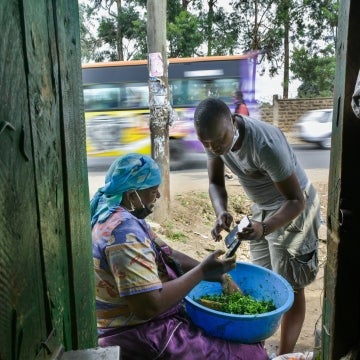From the dusty roadside kiosks of Senegal to the fresh produce markets of Kenya, a slow revolution is underway. QR code stickers cling to glass counters, handwritten USSD codes dangle from shelves next to tomatoes and mangoes, and merchants swipe between apps on smartphones with cracked screens to approve digital payments. Across Sub-Saharan Africa (SSA), code is quietly emerging where cash once held an unshakable grip – but the latest Global Findex 2025 data reveals that this trend is still in its infancy.
Globally, digital merchant payments have surged in the past decade. Digital payments made by retail customers to businesses in store or online grew to 42% of all adults in 2024, up from 35% in 2021. In low- and middle-income countries (excludes China, where 80% of adults made a DMP payment in the last year alone), this stood at 24%. By comparison, in Sub-Saharan Africa, only 20% of adults made a digital merchant payment in 2024—a striking contrast to the region’s otherwise mature mobile money payment ecosystem.
A comparison of two types of digital payments—Person to Person (P2P) vs. Person to Business (P2B) —across eight digitally mature, low- to lower-middle-income Sub-Saharan African countries reveals a consistent trend: person-to-business (P2B) payments lag significantly behind person-to-person (P2P) payments—Kenya being the only exception. When digital P2B payments trail P2P, it suggests that everyday commerce is still largely cash-based, even as individuals have embraced digital wallets for sending money to one another.
Flipping this trend so that P2B leads P2P is urgent if we want to deepen financial inclusion and build resilient economies
In any economy, the volume of merchant payments for daily essentials far exceeds domestic P2P payments. For instance, 50-80% of household expenditure among low-income households in Sub-Saharan Africa is spent on frequently recurring expenses like food, transportation, cooking fuel, and household essentials like dishwashing soap and hygiene products. The fact that digital P2B payments lag P2P payments indicates only one thing: cash still dominates P2B payments even though mobile money is widely accepted for P2P payments.
Additionally, digital merchant payments remain unevenly adopted by different customer segments. There are clear gaps based on wealth, urban-rural, and gender divides. In Sub-Saharan Africa, just 13% of adults in the poorest 40% of households made digital purchases in 2024—nearly half the rate of those in the wealthiest 60%. Urban adults were 13 percentage points more likely than rural ones to transact digitally, and men outpaced women by 7 percentage points. Meaning groups that are traditionally underserved by financial service providers are the ones that are lagging.
Why does this matter?
Cash is invisible. It can’t be tracked. It doesn’t build a record. And that’s the crux of the problem. By comparison, when a merchant accepts a digital payment through a mobile money wallet, QR code, or point-of-sale device, it creates a data point and generates a receipt—both for the merchant and the customer. In other words, it leaves a trace. A stream of those digital payments creates an economic profile for the customer and the merchant. As CGAP recently highlighted in How Digitization Is Disrupting Collateral-Based Lending, payment digitization is disrupting the century-old reliance on physical collateral, which has long excluded women, youth, and small-scale merchants from formal finance.
If digital merchant payments are so beneficial to deepening financial inclusion, why are they still the exception rather than the rule in many parts of the world?
In many low-income communities, the basics—smartphones, mobile coverage, reliable electricity—are still out of reach. The same is true for P2P, but unlike those transactions, a merchant payment is almost always time sensitive: the transaction must go through, or the purchase won’t happen.
Trust is another major issue for P2B: if transactions fail or if fees aren’t clear, both customers and merchants revert to the certainty of cash. In Nigeria, for instance, 42% of businesses say payment failures were a key concern. Cost compounds the issue: even a 1% merchant discount rate (MDR) —where providers charge the merchant 1% of the transaction value processed—can feel punitive for smaller merchants operating on razor-thin margins. Waiving MDR for low-value transactions can be a critical lever. Potential loss leader initiatives, like bKash’s fee exemptions for low-value digital merchant payments in Bangladesh and recent efforts by financial services providers in Uganda and South Africa to zero-rate MDR fees for low-value transactions, can bring micro-merchants into the formal financial system—without penalizing them at the point of sale, while also benefiting providers in the long run.
One of the most overlooked barriers to inclusive finance is the way digital payment systems are designed and classified. In mature mobile money markets, customers who do pay a merchant digitally often use peer-to-peer (P2P) transfers. However, when a P2P feature is used for a merchant payment, financial service providers typically classify it as a remittance—creating a data trail that is markedly different from a business transaction. This misclassification limits the ability to build accurate business profiles or customer spending histories, which are critical for designing more sophisticated financial products. Moreover, P2P payments to businesses often lack the consumer protections that person-to-business (P2B) payments offer in some markets. For example, in India, the central bank mandates automatic processing of refunds and compensation for merchant payment failures—providers cannot wait for customer complaints; their systems must proactively detect failures and resolve them—a protection not required for P2P transactions.
Even when merchants are ready to go digital, though, their customers might not be—driven by sheer habit, confusion, or convenience. In Bangladesh, for example, 80% of bKash users initially said they preferred cash for convenience. But once they tried merchant payments, 90% wanted to keep using them. When digital is easy and trusted, people come back. In India, where the government backed the Unified Payments Interface (UPI) – the largest interoperable payment platform in the country – and zero-rated the merchant discount rate at the beginning, more than 340 million QR codes now sit at merchant counters. And it’s working: over 64% of digital payments that UPI processes are merchant payments. Digital merchant payments exceed digital P2P payments, clearly signaling that India has crossed that inflection point and is now firmly on a digital trajectory.
Accelerating digital merchant payments is about building an enabling ecosystem—from rules and infrastructure to incentives. Policymakers must build the rails, like interoperable instant payment infrastructure, and enforce rules, including tiered Know Your Customer (KYC) processes and simplified onboarding. Whilst financial service providers need to craft compelling value propositions for both merchants and consumers, as is laid out in CGAP’s previous work on this, here. Additionally, they must invest in building reliable systems and processes so that customers can trust that digital payments are safe, affordable, and worth the switch.
In upcoming blogs, we’ll dig deeper into the critical roles each stakeholder plays – examining supply-side readiness, demand-side barriers, regulatory hurdles, and infrastructural gaps – because making digital commerce work isn’t just a technological challenge, it’s a systems challenge, and it’s time for Sub-Saharan Africa to move from potential to momentum.



